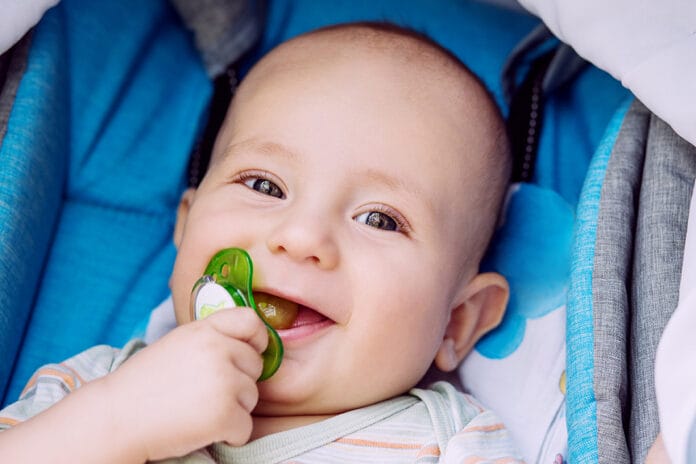Dental hygienists inevitably encounter the question of pacifier use, and it is important to understand the risks and benefits of non-nutritive sucking habits in infants and young children. Pacifier use in some developed countries is so culturally established that the prevalence is up to 42.5% in young children by the age of one year.1
Nutritive sucking habits are those that provide nutrition, such as breast and bottle feeding. Non-nutritive sucking habits (NNSHs), such as pacifier and digit sucking, do not provide nutrition. Sucking is a natural instinct and is an infant’s earliest coordinated muscular activity, benefiting oral motor development. The primary dentition and the tongue are the foundation for the development of permanent dentition in terms of determining space and occlusion for the future development of teeth.2
Pacifiers were first cited in medical literature in 1493 by German physician Bartholomäus Metlinger. They consist of a latex or silicon nipple with a firm plastic shield and handle and are available in different forms and sizes. Conventional pacifier use has been found to have both beneficial and adverse effects on infant development, depending on the duration and frequency of use.1
Benefits of Pacifier Use
Pacifiers are generally accepted in the first year of life to decrease the risk of sudden infant death syndrome, soothe the baby, and reduce the formation of a digit-sucking habit when introduced between one and three months of age.3
Analgesia ‒ Pacifiers are associated with a soothing effect, and are used for pain and anxiety prevention. The palate is a place for the release of serotonin and dopamine and sucking releases those hormones to aid in calming.4 Pacifiers reduce crying time in infants undergoing blood draws or immunizations, especially those younger than three months old.3
Preterm infants ‒ A Cochrane review found NNSHs were associated with shorter hospital stays, earlier transition to bottle feeding from enteral feeding, and improved bottle feeding in preterm infants.3 Pacifier use can also help establish the suckling motion that would have developed in utero for preterm infants.4
Sudden infant death syndrome (SIDS) ‒ The American Academy of Pediatric Dentistry (AAPD) guidelines recommend that parents offer a pacifier after one month of age at the onset of sleep to reduce SIDS risk.5 The exact mechanism of how a pacifier may prevent SIDS is not completely understood; however, pacifier use may decrease the likelihood of rolling into the prone position, maintain airway patency, decrease gastrointestinal reflux and resulting sleep apnea, or increase respiratory drive with carbon dioxide retention.3
Risks of Pacifier Use
Pacifier use has early short-term benefits but carries risks with long-term use depending on frequency and duration.
Candida infection ‒ Pacifiers are often colonized with Candida and bacterial organisms. Latex pacifiers are more significantly colonized with Candida and Staphylococcus than silicone.3
A population-based study of 10,000 infants in the United Kingdom evaluated pacifier use at 15 months of age and its association with infection at 18 months. The 36% of infants who used a pacifier had a higher incidence of earache and colic compared with the 40% of infants who did not suck and the 21% of infants who sucked fingers. The 2.7% of infants who sucked both a pacifier and fingers had more wheezing and earaches and poorer health in the month before the study.3
Otitis media ‒ There are two proposed mechanisms for how pacifier use could cause otitis media. One is the reflux of nasopharyngeal secretions into the middle ear from sucking; the other involves Eustachian tube dysfunction from an altered dental structure.3
Dental malocclusion may play a role in recurrent acute otitis media with a muscle-mediated mechanism. Eustachian tube dysfunction has been connected to the functionality of the tensor veli palatini and levator veli palatini muscles, which could be altered in patients with cranial skeletal development syndrome. Another possibility is a TMJ disorder that influences Eustachian tube patency. The mandibular condyles are normally located next to the anterosuperior wall of the joint cavity, but in children with altered craniofacial development, the condyles could dislocate to a rear position in the joint cavities, closer to the Eustachian tube and middle ear.6
Breastfeeding ‒ Pacifier use is associated with early breast weaning. The American Academy of Pediatrics recommends introducing a pacifier at one month of age for breastfeeding infants to avoid negative effects on feeding.3 Use of pacifiers too early may interfere with breastfeeding and proper sucking. Pure breastfeeding is associated with reduced chances of developing abnormal primary dentition, lower chances of class II incisal relationship, and increased overjet. Children with pure breastfeeding for at least six months have wider intercanine and intermolar widths.2
Oral Manifestations of Pacifier Use
The prolonged duration of sucking habits produces harmful functional stimuli, which may jeopardize the position and strength of stomatognathic structures, with a detrimental impact on oral functions, including mastication, breathing, and speech.7 The prevalence of malocclusion in children who used a pacifier for more than four years was 71%, compared to 32% in children who stopped use between three to four years and 14% in those who stopped before two years.3
Malocclusion is a developmental disorder of the maxillofacial system that results from genetic and environmental factors and affects the jaw, tongue, and soft tissues.2 NNSHs are associated with smaller maxillary intercanine and intermolar widths, increased posterior crossbite, and vaulted palates, which lead to a smaller nasal airway.2,4
The increased activity of the cheeks, together with reduced lingual support for the deciduous upper molars and canines ‒ as the tongue is forced backward and downward by the pacifier nipple ‒ contributes to the decreased maxillary intercanine width found.7 Negative pressure created by sucking will accentuate a crossbite.4
Conventional pacifier use is associated with a statistically significant increase in mandibular canine arch width and a statistically significant decrease in palatal depths.1 Ling et al. found an association between pacifier use and digit sucking with an open bite in the vertical dimension. Pressure from the pacifier or digit hinders the downward and 3-dimensional growth of the anterior maxillary base and delays the anterior teeth from erupting while the posterior teeth continue to erupt. This results in the overeruption of posterior teeth and an open bite.2,4 Anterior open bite is more likely to develop with greater than two years of pacifier use.1
Prolonged pacifier habits are associated with the development of posterior crossbites and prolonged digit habits with increased overjet. Both are associated with an increased prevalence of reduced overbite and anterior open bite.8 The prevalence of overjet greater than 2 mm was 67.5% of children with pacifier-sucking habits compared to 35.5% of children who did not use a pacifier and a higher average of overjet of more than 4 mm was found in 28% of pacifier users compared to 4% of non-pacifier users with no sucking habits.1
Conventional long-duration, high-frequency pacifier use is linked to the hyperfunction of the buccinator muscle, which causes a deficiency in transverse growth of the maxilla and increases the frequency of crossbites.9
Effects of Pacifier Use on Speech and Breathing
Speech may be affected by tooth and tongue position. Dental arches act as structural boundaries for the placement of the tongue and lips and are intricately involved in sound production.7 There is a significant relationship between increased overjet and distortions of the “s” sound. An open bite may contribute to a lisp.8 Certified Orofacial Myologist Patricia Brinkman-Falter notes that these children often develop lateral lisps because they learn to talk with the pacifier in their mouth, and the sides of the tongue end up making the sound because the tip cannot reach the correct placement.4
Children with a pacifier habit of at least two years scored less in breathing evaluations. They showed more oronasal or mouth breathing aspects before intervention for the cessation of pacifier use. In oronasal breathing, lips are not sealed, the suprahyoid muscles open the jaw, and this displacement is followed by the tongue.7 During oronasal breathing, the soft palate lies between the tongue and the posterior pharyngeal wall. When both the mouth and nose are open, the soft palate becomes responsible for the partitioning of oronasal flow.10
Orthodontic Pacifiers
Orthodontic pacifiers were introduced to reduce conventional pacifier use with dental malocclusion. Orthodontic pacifiers are designed with a flattened nipple to simulate a mother’s nipple anatomy, maintain the tongue’s necessary pressure on the palatal vault, and obtain a more acceptable tongue position and lip seal.9
These pacifiers are supposed to replicate the patterns of muscle contraction, tongue position, and nasal breathing, similar to breastfeeding.9 The prevalence of anterior open bite, posterior crossbite, overjet, and distal step of primary molars is more prominent in children who used conventional pacifiers versus orthodontic pacifiers.1
Safe Pacifier Use
● Wait until breastfeeding is going well before introducing a pacifier.
● Let the infant decide whether to use the pacifier; do not force.
● Offer only at nap and bedtimes.
● Do not coat the pacifier.
● Never attach a pacifier to the wrist, neck, or crib.
● Clean and replace the pacifier regularly.
● Check for wear and tear.
● Do not share pacifiers or “clean” the pacifier with your mouth.11
Pacifier Removal
There is no standard intervention for the cessation of NNSHs.7 The American Academy of Pediatrics and the American Academy of Family Physicians recommend weaning from pacifier use after six months old.3
Tips for Pacifier Removal/Weaning
● Take the pacifier away gradually, starting around six to nine months. When the child learns to chew, it should be discontinued by one year.
● Substitute chewing toys.
● Use alternative soothing methods like swaddling, rocking, or infant massage.
● Poke holes in the pacifier to make it less satisfying to suck.
● Apply an aversive-tasting substance to the pacifier, like an over-the-counter bitter cream made specifically to deter thumb-sucking and nail-biting.
● Depending on age, have the child throw the pacifier away.
● Consider a “pacifier fairy” removing the pacifier.
● Implement positive reinforcement for behavior modification.3,4,8,11
It should be noted that some structural and developmental changes associated with pacifier use may self-correct with normal growth. Scudine et al. conducted a study in which the baseline for patients in the pacifier group for an open bite was 85%, but only 8% and 4% at six months and one-year following pacifier removal, respectively. Increased overjet in the pacifier group at baseline was 68% but improved to 42% and 21% at the six-month and one-year follow-ups after removal, respectively.7
This was the first study to provide a comprehensive description of the improvement in maxillary and mandibular intercanine widths, together with the breathing and speech functions, after the interruption of pacifier habit, overcoming the oro-dentofacial changes found at baseline. The children in the control group had significantly less occurrence and degree of changes in occlusion and oral myofunctional structures than their counterparts.7
Conclusion
Non-nutritive sucking habits have a short window of benefit; however, there is an increased risk with prolonged use. Dental hygienists can educate new parents, grandparents, and caretakers on nutritive and non-nutritive sucking habits, helping them to understand the risks and benefits of short and long-term use. Ask about non-nutritive sucking habits at pediatric dental appointments and offer a short list concerning safe pacifier use, cleaning and care, and tips for weaning.
Before you leave, check out the Today’s RDH self-study CE courses. All courses are peer-reviewed and non-sponsored to focus solely on high-quality education. Click here now.
Listen to the Today’s RDH Dental Hygiene Podcast Below:
References
- Schmid, K.M., Kugler, R., Nalabothu, P., et al. The Effect of Pacifier Sucking on Orofacial Structures: A Systematic Literature Review. Progress in Orthodontics. 2018; 19(1): 8. https://doi.org/10.1186/s40510-018-0206-4
- Ling, H., Sum, F., Zhang, L., et al. The Association Between Nutritive, Non-Nutritive Sucking Habits and Primary Dental Occlusion. BMC Oral Health. 2018; 18(1): 145. https://doi.org/10.1186/s12903-018-0610-7
- Sexton, S., Natale, R. Risks and Benefits of Pacifiers. American Family Physician. 2009; 79(8): 681-685. https://www.aafp.org/pubs/afp/issues/2009/0415/p681.html
- Patricia Brinkman-Falter. (2022, September 15). Board Certified Orofacial Myologist. Nebraska Myofunctional Specialties.
- Policy on Pacifiers. (2022). American Academy of Pediatric Dentistry. https://www.aapd.org/globalassets/media/policies_guidelines/p_pacifiers.pdf
- Bernkopf, E., Lovato, A., Bernkopf, G., et al. Outcomes of Recurrent Acute Otitis Media in Children Treated for Dental Malocclusion: A Preliminary Report. BioMed Research International. 2016; 2016: 2473059. https://doi.org/10.1155/2016/2473059
- Scudine, K., de Freitas, C.N., Nascimento de Moraes, K., et al. Multidisciplinary Evaluation of Pacifier Removal on Oro-Dentofacial Structures: A Controlled Clinical Trial. Frontiers in Pediatrics. 2021; 9: 703695. https://doi.org/10.3389/fped.2021.703695
- Borrie, F.R., Bearn, D.R., Innes, N.P., Iheozor-Ejiofor, Z. Interventions for the Cessation of Non-Nutritive Sucking Habits in Children. The Cochrane Database of Systematic Reviews. 2015; 3: CD008694. https://doi.org/10.1002/14651858.CD008694.pub2
- Caruso, S., Nota, A., Darvizeh, A., et al. Poor Oral Habits and Malocclusions After Usage of Orthodontic Pacifiers: An Observational Study on 3-5 Years Old Children. BMC Pediatrics. 2019; 19(1): 294. https://doi.org/10.1186/s12887-019-1668-3
- Rodenstein, D.O., Stănescu, D.C. Soft Palate and Oronasal Breathing in Humans. Journal of Applied Physiology. 1984; 57(3): 651-657. https://doi.org/10.1152/jappl.1984.57.3.651
- Using Pacifiers Safely. (2023, April 26). Head Start Early Childhood Learning & Knowledge Center. https://eclkc.ohs.acf.hhs.gov/oral-health/brush-oral-health/using-pacifiers-safely












